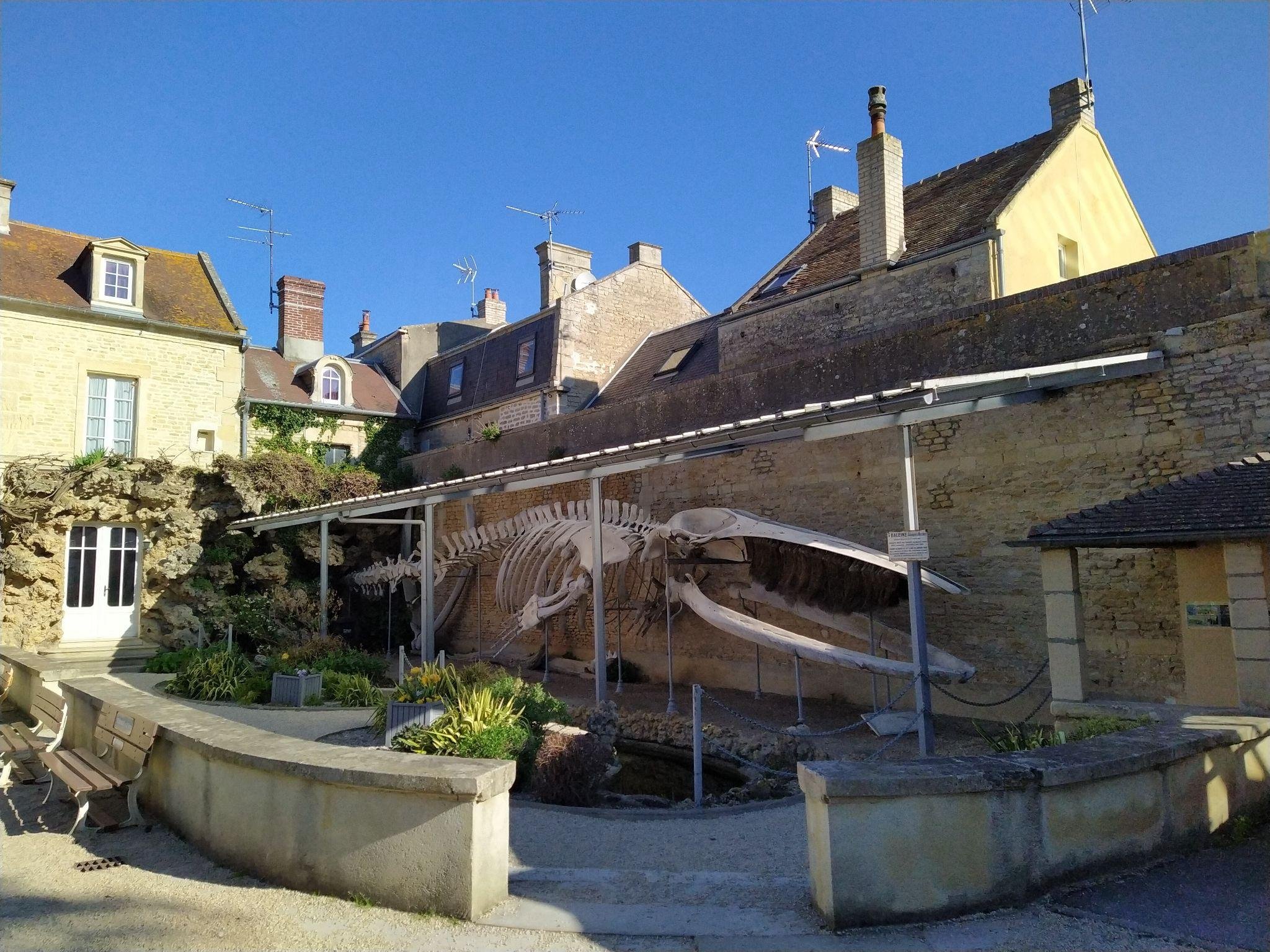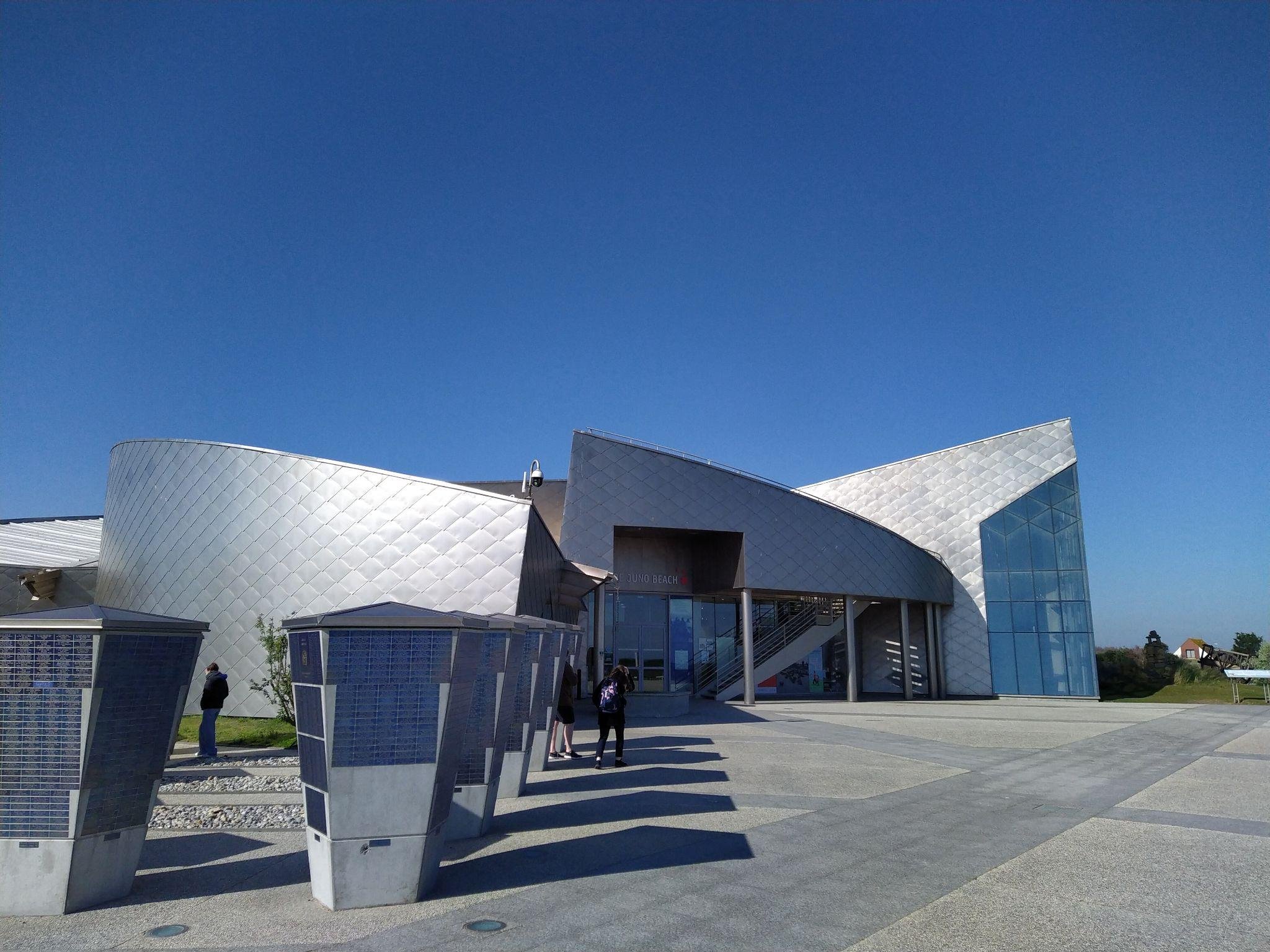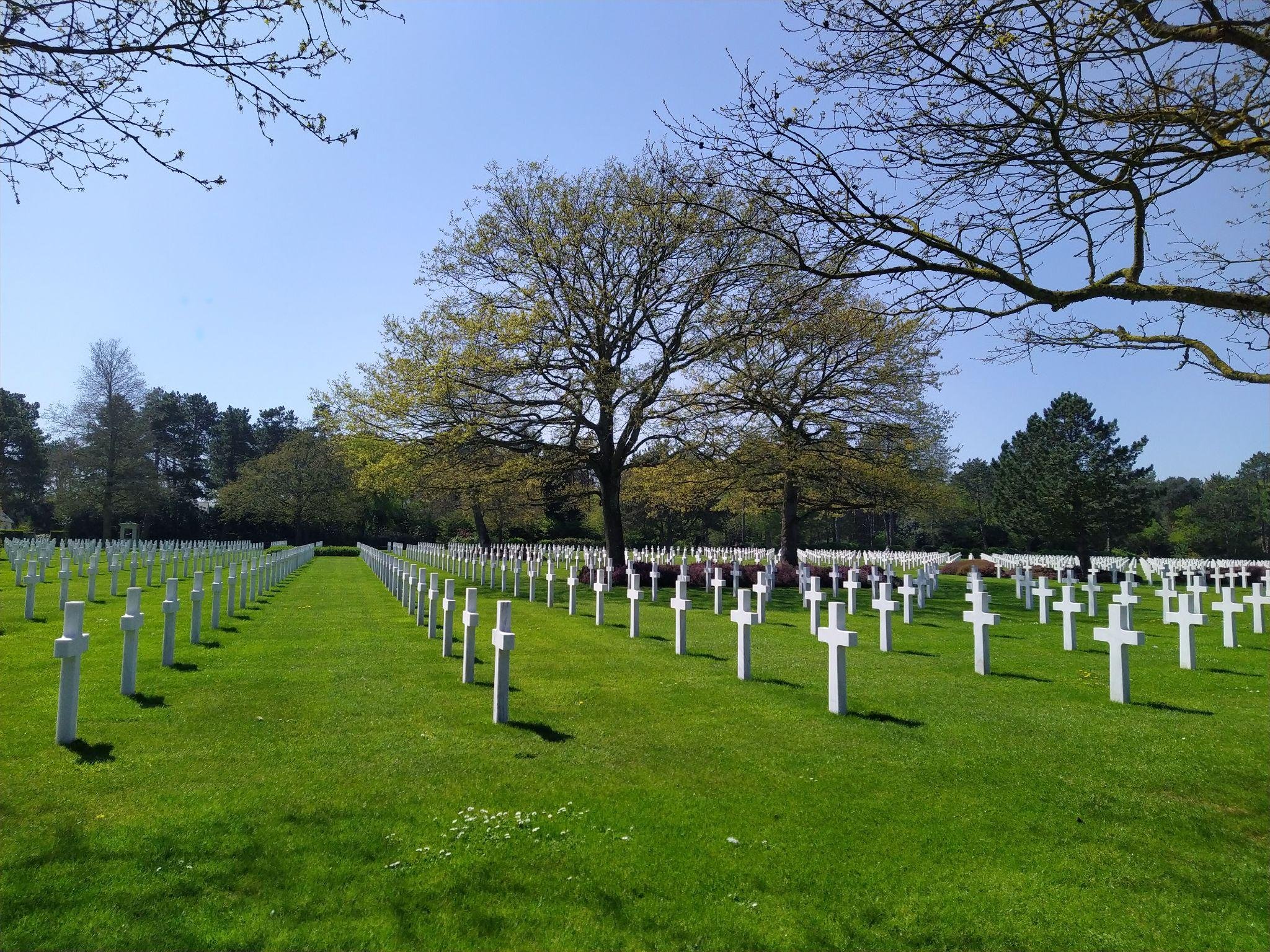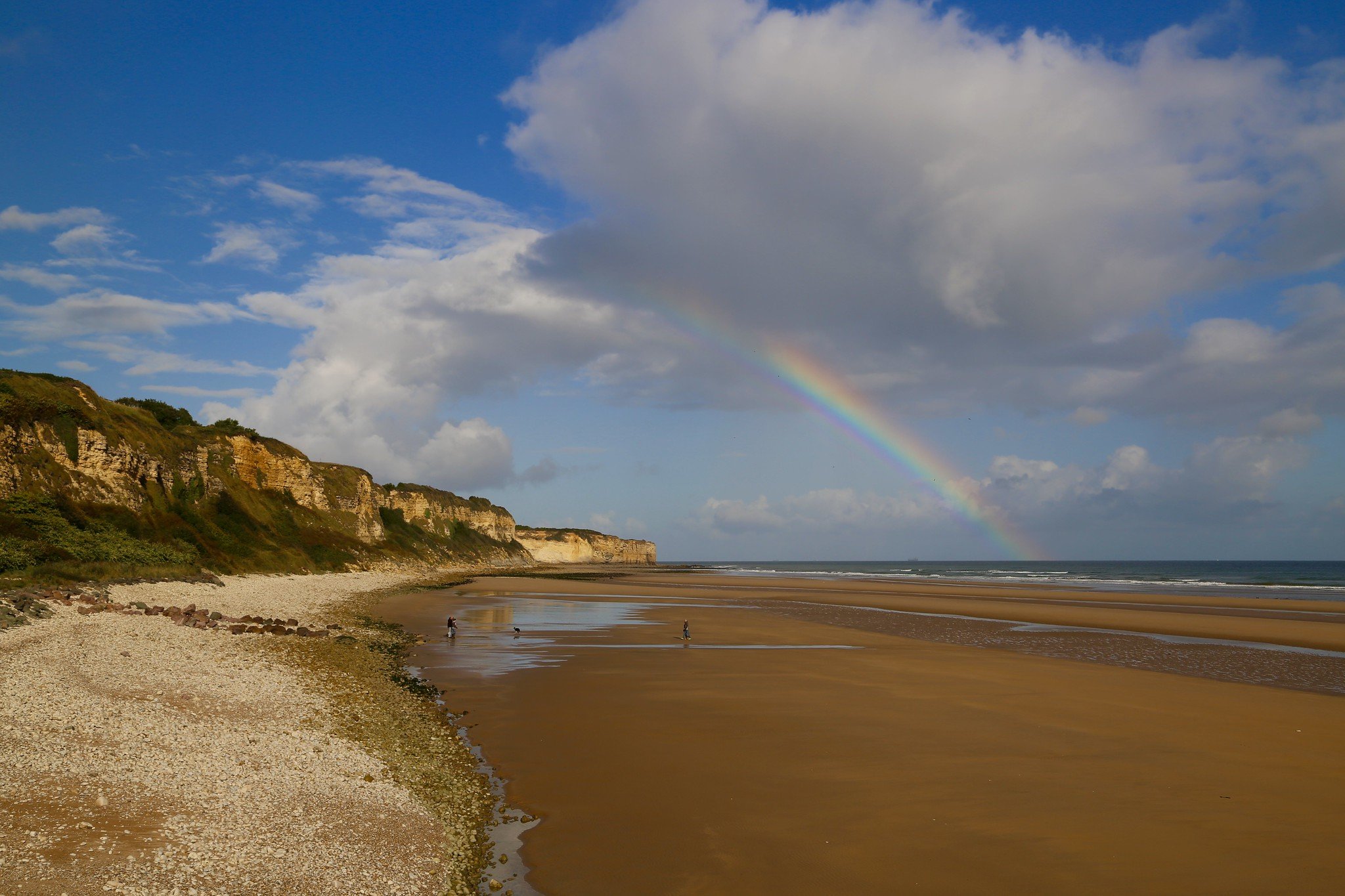If you decide this June to take off along the 514 departmental road from the ferry port at Ouistreham, you will find a steady stream of warfighting debris taken out of the sea and monumentalized.
World War Two saw the largest marine landing assault in history on D-Day, June 6th, 1944, and the evidence is everywhere, from children’s playgrounds to municipal flower gardens.
But as you take the trail that leads to the American Cemetery at Omaha Beach, there are other historical diversions along the way. There are reminders of America’s peace-time pioneering intercontinental prowess and the life that shares the sea where so many men died.

Luc-su-Mer on Sword Beach
There is a tug-of-war going on in Luc-sur-Mer, between the faded grandeur of the belle-epoch frontage, the weather-beaten hotel facades, and the modern casino, café, and hammam on the beachfront. When the tide is in it crashes over the handrail on the promenade, and the wind never seems to cease blowing.
Walk inland, up the narrow Rue de la Mer to the Mayor’s office, and turn left through the arched carriageway. Here there is the skeleton of a whale, preserved in the park for a century. The beast washed ashore in 1885 and quickly became a popular tourist draw.
These huge creatures still patrol the shipping lanes of the English Channel and are often sighted from the decks of cross-channel ferries. At Luc-sur-Mer, in the quiet courtyard that is the whale’s final resting place having been given up by the sea, it is a reminder that there is another world below the surface.
Sword Beach was the easternmost landing site, the responsibility of the British army, and supported by Polish and Norwegian naval elements. British and French commandos encountered tough resistance in the seaside town of Ouistreham where this modern journey begins, but were able to accomplish all objectives with low losses.

Courseulles-sur-Mer on Juno Beach
It’s hard to imagine the trial of D-Day when you arrive in Courseulles-sur-Mer, as you pass through the vast holiday village that has grown up between the D514 and the beach. Perhaps it’s a fitting legacy that so many should want to come here on vacation.
Right on the seafront, at the mouth of the River Seulles is the Canadian Juno Beach Centre where you can tour a claustrophobic concrete Nazi bunker. Along the riverside walk, there is a Nazi anti-tank gun, battered by a direct hit.
In the midst of a municipal flower bed, a Duplex Drive Sherman Tank is planted, recovered from the sea bed. It never made it to shore when it was shiny and new, and finally made landfall in 1971

Ver-sur-Mer on Gold Beach
At Ver-sur-Mer is the British D-Day memorial. You park on top of a windswept hill, then walk past a series of monumental stone slabs that tell the story of the invasion in English and in French. The names of the dead are inscribed on numerous stone pillars.
I found two men here that shared my own name. Driver E. A. Bingham and Rifleman S. H. Bingham were both killed on the same day. From the same regiment and born three years apart and memorialized together, I could only wonder whether they had been brothers.
In the center of town, there is another museum. This one is dedicated to the pioneering aircraft America, that came down in the sea in 1927 after a record-breaking flight across the North Atlantic.
Newsreels and an interactive display tell the story of the four aviators that made history, bringing the first intercontinental airborne postal service to the USA and Europe. Press a button and in one diorama the speech by the lead pilot Byrd rings out across the museum.
Colleville-sur-Mer on Omaha Beach
As you wind your way along the departmental road on your way to Colleville-sur-Mer be aware that there are coach tours that run up and down this stretch, making progress difficult, especially through the tiny hamlets dotted along the way.
Large billboards depicting the American Allied Forces arriving on the beaches and in the villages of Normandy are fixed on the sides of buildings. Old sepia-toned portraits of soldiers, artillerymen, officers, and gunners adorn flagposts, entryways, and barns.
Everywhere you go there are small memorials to single acts of courage and determination on the battlefield. On some, you will find a small bunch of wildflowers left in tribute, a collection of seashells, or a cairn of pebbles.
And then you’re out of the winding country lanes that twist and turn and enter an immaculate, wide, tree-lined avenue, perfectly surfaced and maintained. It is the road to the American Cemetery.

American memorial
From the car park, it’s a short walk to the visitor center, a low, unassuming building that looks no bigger than a municipal railway station. Through the door, French Gendarmes politely request you pass through an airport metal scanner before entry.
On this level you can search the database for the names of the dead commemorated here, and their location amongst the 9,387 headstones. Downstairs is a new kind of bunker experience, a recently opened museum and theater space dedicated to bringing the world of June 1944 to life.
Not only are there the stories of politicians and generals but also the tales of simple heroism by those caught up in the melée of battle, storming Omaha Beach to secure European liberation from Hitler’s Nazi dictatorship. On the way out there is a recording of a voice, reading out the names of all the deceased. A memorial in sound.
From the exit to the Visitor Center, a path winds up toward the clifftop over Omaha Beach. The waves break gently against the rocks below and a breeze hushes through the pine trees fringed along its edge. There are a lot of people about when I visit, kids on a school trip, families talking quietly together, and servicemen paying tribute.
It’s a peaceful place, even with the gardeners engaged in essential tree trimming and grass cutting. None of it feels intrusive as you stand at the monument and look out across the vast field of headstones, set in 172 acres of grounds. Here there are forty-five sets of brothers, also lost together on D-Day.
In spite of the regulation symmetry of death depicted here, the cemetery has a powerful American thread of dynamic optimism, reflected in the leaping statue that reaches for the sun which is the centerpiece of the memorial.
The quiet perfection of the immaculately kept cemetery is in direct counterpoint to the chaos and destruction presented below ground in the subterranean visitor center. It resonates with a peace sorely captured amidst a demagogic period of world history.
Return to Bayeux
The Overlord Museum, on the way back from the cemetery, has perhaps the largest gift shop I have ever seen, and it is free to walk around until you are tempted, and buy something. Perhaps a souvenir rifle bullet key ring (Top-tip: don’t try to take it home in your hand luggage).
On the grounds of the museum, there is a display of tanks, an M4 A1 Sherman, battered, but restored for display, stands guard by the approach road.
There are more war museums in the nearby city of Bayeux, declared the temporary capital of France by Charles de-Gaulle following its liberation. The commemoration of a battle that took place almost a thousand years ago, in the Bayeux Tapestry Museum makes me wonder whether it could all happen again. WaL
PICTURED ABOVE: Omaha Beach near Vierville-sur-Mer. PC: JR P – CC 3.0.
If you think the stories you’ve just read were worth a few dollars, consider donating here to our modest $500-a-year administration costs.



